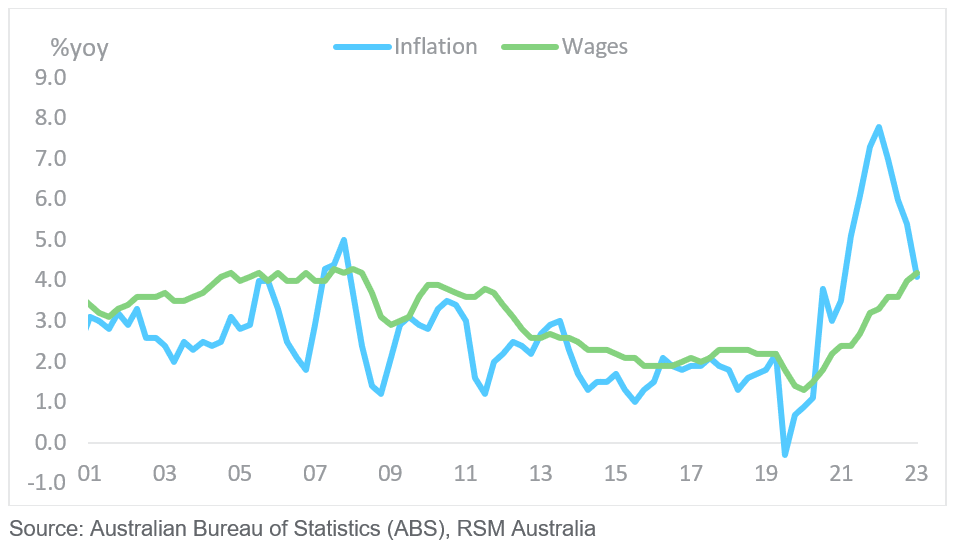Today’s figures from the Australian Bureau of Statistics (ABS) reveal a 0.9% sequential increase in the Wage Price Index (WPI) for the December 2023 quarter, signaling a 4.2% annual rise.
The uptick in wages was led by the highest quarterly rise in 15 years in public sector wages.
Public sector wages grew 1.3% quarter-on-quarter supported by centralised wages revisions. Centralised wages revisions included the “newly implemented enterprise agreements for essential workers in the Health care and social assistance and Education and training industries following changes to state-based wages policies.”, as noted by the ABS. Meanwhile private sector wages grew 0.9% over the quarter.
The shift in the public-private sector dynamic in the December 2023 quarter is noteworthy. Usually, the private sector drives WPI growth, given its larger workforce and wage expenditure compared to the public sector. It's also more responsive to labour market changes due to a higher proportion of individually arranged jobs. While the public sector typically contributes 10% to 25% to overall wage growth, this quarter witnessed a notably higher contribution at 34%.
EXHIBIT 1: Wages outpacing inflation in 4Q23

Monetary Policy Implications
There are two ways to look at today’s data.
Firstly, the good news. Australia is seeing an increase in real wages. The last time annual wages growth exceeded annual inflation was in March 2021, during the height of the COVID-19 pandemic. That’s a long time for Australians to go without a real pay rise.
Secondly, today’s data stresses the importance of the central bank maintaining a vigilant stance. The Board has previously stated that a 4% wage growth aligns with the central bank’s 2%-3% inflation target, however it is important that productivity ticks up too. The risk of a slower than anticipated return of inflation to target levels increases the likelihood of upward salary negotiations to alleviate the pressure of living costs, potentially prompting businesses to transfer these costs to consumers, creating a price-wage spiral.
We continue to expect the RBA to maintain its current stance until the third quarter of 2024. The easing of inflationary and wage pressures is welcome news but it's still too soon to let the guard down.
The RBA’s liaison surveys have indicated that businesses continue to be concerned about the weakness in demand. They expect this weakness to translate to lesser revenue particularly in the wake of robust labour and other input costs. Consequently, it is fair to expect implementation of cost reduction strategies, which will be reflected in both employment intentions and projected wages growth in the months ahead.
4Q23 WPI Movers and Shakers
In the education and training sector, there was a significant quarterly increase of 1.7%, driven by out-of-cycle raises linked to public sector wage agreements. Conversely, the accommodation and food services industry experienced the smallest quarterly rise at 0.3%. On a yearly basis, the health care and social assistance industry marked the highest growth at 5.5%, a record high since the series began. In contrast, the finance and insurance services sector reported the lowest yearly growth at 3.2%.
Statewise, New South Wales reported the highest quarterly wage increase at 1.3%, while Tasmania and the Australian Capital Territory had the lowest movement at 0.5%. On a year-ago basis, Queensland experienced the highest annual wage movement at 4.8%. In contrast, Victoria reported the lowest yearly movement at 3.7%.
EXHIBIT 2: Nationwide wages growth in 4Q23

FOR MORE INFORMATION
If you would like to learn more about the topics discussed in this article, please contact Devika Shivadekar.
Devika Shivadekar

Devika Shivadekar, our seasoned economist, boasts extensive expertise in macro-economic and financial research across APAC. With over 8 years of experience, including roles at the Reserve Bank of India and a top investment bank, she now excels at RSM, aiding middle-market clients in making informed business decisions.
Her passion lies in simplifying economic data for clients' comprehension. Devika closely monitors macroeconomic indicators, such as growth and inflation, to gauge economic health.Get in touch with Devika >






